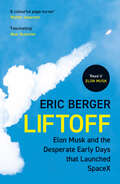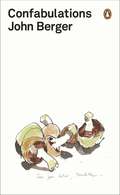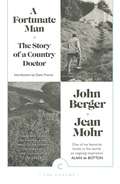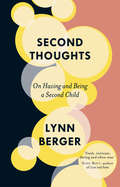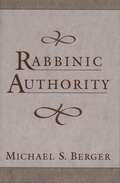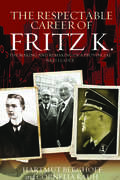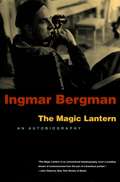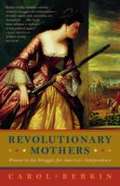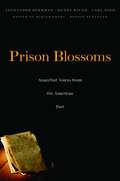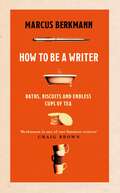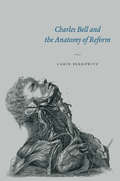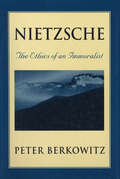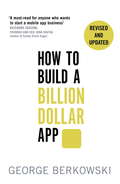- Table View
- List View
Liftoff: Elon Musk And The Desperate Early Days That Launched Spacex
by Eric BergerThe dramatic inside story of the first four historic flights that launched SpaceX—and Elon Musk—from a shaky startup into the world's leading edge rocket company.
Confabulations
by John Berger'Language is a body, a living creature ... and this creature's home is the inarticulate as well as the articulate'. John Berger's work has revolutionized the way we understand visual language. In this new book he writes about language itself, and how it relates to thought, art, song, storytelling and political discourse today. Also containing Berger's own drawings, notes, memories and reflections on everything from Albert Camus to global capitalism, Confabulations takes us to what is 'true, essential and urgent'.
A Fortunate Man: The Story of a Country Doctor (Canons #43)
by John BergerIn 1966 John Berger spent three months in the Forest of Dean shadowing an English country GP, John Sassall. Sassall is a fortunate man - his work occupies and fulfils him, he lives amongst the patients he treats, the line between his life and his work is happily blurred. In A Fortunate Man, Berger's text and the photography of Jean Mohr reveal with extraordinary intensity the life of a remarkable man. It is a portrait of one selfless individual and the rural community for which he became the hub. Drawing on psychology, biography and medicine A Fortunate Man is a portrait of sacrifice. It is also a profound exploration of what it means to be a doctor, to serve a community and to heal. With a new introduction by writer and GP, Gavin Francis.
Titian: Nymph and Shepherd (Pegasus Library)
by John Berger Katya BergerThis book is first a dialogue between a daughter and a father about life, physical sensation, mortality. Both seem to listen to the other with great attention. Secondly it is the extraordinary vehicle for a series of insights into the everyday life and the art of the great Venetian master, following an uncanny incident at the large exhibition of his work staged in Venice in 1990. While attending the exhibition Katya meets an old man, who she becomes convinced can only be the ghost of the great painter. Her 'spiritual' visitor engages her in conversation about the minute particularities of painting some of the pictures there. She shares this experience with her father in a letter. He accepts the encounter at face value and discusses the historical background to the old man's remarks, seeking answers to a series of evidential questions about his daughter's encounter. From then on, the three of them, the old painter, the daughter, and the father discuss animals, Greece, fur, sexuality, the strangeness of drawing.
Elie Wiesel: Confronting the Silence (Jewish Lives)
by Joseph BergerAn intimate look at Elie Wiesel, author of the seminal Holocaust memoir Night and recipient of the Nobel Peace Prize As an orphaned survivor and witness to the horrors of Auschwitz, Elie Wiesel (1928–2016) compelled the world to confront the Holocaust with his searing memoir Night. How did this soft-spoken man from a small Carpathian town become such an influential figure on the world stage? Drawing on Wiesel’s prodigious literary output and interviews with his family, friends, scholars, and critics, Joseph Berger seeks to answer this question. Berger explores Wiesel’s Hasidic childhood in Sighet, his postwar years spent rebuilding his life from the ashes in France, his transformation into a Parisian intellectual, his failed attempts at romance, his years scraping together a living in America as a journalist, his decision to marry and have a child, his emergence as a spokesperson for Holocaust survivors and persecuted peoples throughout the world, his lifelong devotion to the state of Israel, and his difficult final years. Through this penetrating portrait we come to know intimately the man the Norwegian Nobel Committee called “a messenger to mankind.&rdquo
Second Thoughts: On Having and Being a Second Child
by Lynn BergerA beautifully written account of a quest, both personal and scientific, to better understand the impact and experience of the second child.'There are entire shelves filled with books on parenthood, from fairy tales, novels and memoirs to polemics and collections of essays. But while I was expecting our second child, I realised that we have surprisingly few words for this particular new experience.'While every parent knows more of what to expect the next time round, the birth of a second child is no less momentous. Family relationships multiply, birth-order myths hover and sibling rivalry and parental exhaustion threaten. Yet the potential for joy and love within the family also expands, as if by magic.This new literary talent shines a tender insight on a forgotten subject: what it is to parent for the second time and what it is to forever be a younger child.'Beautifully written, deeply humane, a gem of a book.' Rutger Bregman, author of Humankind: A Hopeful History
Rabbinic Authority
by Michael S. BergerThe Rabbis of the first five centuries of the Common Era loom large in the Jewish tradition. Until the modern period, Jews viewed the Rabbinic traditions as the authoritative contents of their covenant with God, and scholars debated the meanings of these ancient Sages words. Even after the eighteenth century, when varied denominations emerged within Judaism, each with its own approach to the tradition, the literary legacy of the talmudic Sages continued to be consulted. In this book, Michael S. Berger analyzes the notion of Rabbinic authority from a philosophical standpoint. He sets out a typology of theories that can be used to understand the authority of these Sages, showing the coherence of each, its strengths and weaknesses, and what aspects of the Rabbinic enterprise it covers. His careful and thorough analysis reveals that owing to the multifaceted character of the Rabbinic enterprise, no single theory is adequate to fully ground Rabbinic authority as traditionally understood. The final section of the book argues that the notion of Rabbinic authority may indeed have been transformed over time, even as it retained the original name. Drawing on the debates about legal hermeneutics between Ronald Dworkin and Stanley Fish, Berger introduces the idea that Rabbinic authority is not a strict consequence of a preexisting theory, but rather is embedded in a form of life that includes text, interpretation, and practices. Rabbinic authority is shown to be a nuanced concept unique to Judaism, in that it is taken to justify those sorts of activities which in turn actually deepen the authority itself. Students of Judaism and philosophers of religion in general will be intrigued by this philosophical examination of a central issue of Judaism, conducted with unprecedented rigor and refreshing creative insight.
The Respectable Career of Fritz K.: The Making and Remaking of a Provincial Nazi Leader (Studies in German History #18)
by Hartmut Berghoff Cornelia RauhEntrepreneur and Nazi functionary Fritz Kiehn lived through almost 100 years of German history, from the Bismarck era to the late Bonn Republic. A successful manufacturer, Kiehn joined the Nazi Party in 1930 and obtained a number of influential posts after 1933, making him one of the most powerful Nazi functionaries in southern Germany. These posts allowed him ample opportunity to profit from “Aryanizations” and state contracts. After 1945, he restored his reputation, was close to Adenauer's CDU during Germany's economic miracle, and was a respected and honored citizen in Trossingen. Kiehn's biography provides a key to understanding the political upheavals of the twentieth century, especially the workings of the corrupt Nazi system as well as the “coming to terms” with National Socialism in the Federal Republic.
The Magic Lantern: An Autobiography
by Ingmar Bergman“When a film is not a document, it is a dream. . . . At the editing table, when I run the strip of film through, frame by frame, I still feel that dizzy sense of magic of my childhood.” Bergman, who has conveyed this heady sense of wonder and vision to moviegoers for decades, traces his lifelong love affair with film in his breathtakingly visual autobiography, The Magic Lantern. More grand mosaic than linear account, Bergman’s vignettes trace his life from a rural Swedish childhood through his work in theater to Hollywood’s golden age, and a tumultuous romantic history that includes five wives and more than a few mistresses. Throughout, Bergman recounts his life in a series of deeply personal flashbacks that document some of the most important moments in twentieth-century filmmaking as well as the private obsessions of the man behind them. Ambitious in scope yet sensitively wrought, The Magic Lantern is a window to the mind of one of our era’s great geniuses. “[Bergman] has found a way to show the soul’s landscape . . . . Many gripping revelations.”—New York Times Book Review “Joan Tate’s translation of this book has delicacy and true pitch . . . The Magic Lantern is as personal and penetrating as a Bergman film, wry, shadowy, austere.”—New Republic “[Bergman] keeps returning to his past, reassessing it, distilling its meaning, offering it to his audiences in dazzling new shapes.”—New York Times “What Bergman does relate, particularly his tangled relationships with his parents, is not only illuminating but quite moving. No ‘tell-all’ book this one, but revealing in ways that much longer and allegedly ‘franker’ books are not.”—Library Journal
A Very Human Ending: How suicide haunts our species
by Jesse Bering'This book touches on some deep questions relevant to us all... A fascinating, thoughtful, unflinching meditation on one of the most intriguing and curious aspects of the human condition.' - Dr Frank TallisWhy do people want to kill themselves? Despite the prevalence of suicide in the developed world, it's a question most of us fail to ask. On hearing news of a suicide we are devastated, but overwhelmingly we feel disbelief.In A Very Human Ending, research psychologist Jesse Bering lifts the lid on this taboo subject, examining the suicidal mindset from the inside out to reveal the subtle tricks the mind can play when we're easy emotional prey. In raising challenging questions Bering tests our contradictory superstitions about the act itself. Combining cutting-edge research with investigative journalism and first-person testimony, Bering also addresses the history of suicide and its evolutionary inheritance to offer a personal, accessible, yet scientifically sound examination of why we are the only species on earth that deliberately ends its own life.This penetrating analysis aims to demystify a subject that knows no cultural or demographic boundaries.
Dr. John Mitchell: The Man Who Made the Map of North America
by Edmund BerkeleyThis is the first full-length biography of a man who was primarily a botanist but who is best known for his map of North America. He left a well-established medical practice in his native Virginia in 1746 to live in London where he became active in scientific, social, and political circles. One of the period's outstanding cartographical achievements, Mitchell's map served as the basis for the Treaty of 1783 and for the still-existing United States-Canadian border.Originally published in 1974.A UNC Press Enduring Edition -- UNC Press Enduring Editions use the latest in digital technology to make available again books from our distinguished backlist that were previously out of print. These editions are published unaltered from the original, and are presented in affordable paperback formats, bringing readers both historical and cultural value.
Prison Blossoms: Anarchist Voices from the American Past (The John Harvard Library)
by Alexander Berkman Henry Bauer Carl NoldIn 1892, unrepentant anarchists Alexander Berkman, Henry Bauer, and Carl Nold were sent to the Western Pennsylvania State Penitentiary for the attempted assassination of steel tycoon Henry Clay Frick. Searching for a way to continue their radical politics and to proselytize among their fellow inmates, these men circulated messages of hope and engagement via primitive means and sympathetic prisoners. On odd bits of paper, in German and in English, they shared their thoughts and feelings in a handwritten clandestine magazine called “Prison Blossoms.” This extraordinary series of essays on anarchism and revolutionary deeds, of prison portraits and narratives of homosexuality among inmates, and utopian poems and fables of a new world to come not only exposed the brutal conditions in American prisons, where punishment cells and starvation diets reigned, but expressed a continuing faith in the "beautiful ideal" of communal anarchism.Most of the "Prison Blossoms" were smuggled out of the penitentiary to fellow comrades, including Emma Goldman, as the nucleus of an exposé of prison conditions in America’s Gilded Age. Those that survived relatively unrecognized for a century in an international archive are here transcribed, translated, edited, and published for the first time. Born at a unique historical moment, when European anarchism and American labor unrest converged, as each sought to repel the excesses of monopoly capitalism, these prison blossoms peer into the heart of political radicalism and its fervent hope of freedom from state and religious coercion.
Prison Blossoms: Anarchist Voices From The American Past (The John Harvard Library)
by Alexander Berkman Henry Bauer Carl Nold Miriam Brody Bonnie Cleo BuettnerPublished here for the first time is a crucial document in the history of American radicalism—the "Prison Blossoms," a series of essays, narratives, poems, and fables composed by three activist anarchists imprisoned for the 1892 assault on anti-union steel tycoon Henry Clay Frick.
How to Be a Writer: Baths, Biscuits and Endless Cups of Tea
by Marcus BerkmannMarcus Berkmann has been a freelance writer since 1988, working for newspapers and magazines and occasionally writing a book, like this one. He reckons to have written literally millions of words in that time, several of them in the right order. This, his 13th or possibly 14th book, is about those years of writing: the triumphs (few), the heartbreaks (many), the sackings (more than you would expect), the biscuits (many, many more than you would expect). In it he somehow makes the act of staring out of a window wondering what to say next seem both fascinating and, in some strange way, enviable, whereas, like most writers, he rarely leaves the house other than to go to the pub or the off-licence. Often asked how you become a writer, his advice remains: Please do not. There's already enough competition out there and we don't need any more. His advance for this book was about enough to buy a packet of Jaffa Cakes.
A Shed Of One's Own: Midlife Without the Crisis
by Marcus BerkmannFor many men, middle age arrives too fast and without due warning. One day you are young, free and single; the next you are bald, fat and washed-up, with weird tendrils of hair growing out of your ears. None of it seems fair. With age should come dignity and respect, but instead everyone makes tired jokes about buying a motorbike.Marcus Berkmann isn't having it. Having marked his fiftieth birthday by hiding under the duvet for six weeks, the author of the cricket classics Rain Men and Zimmer Men is now determined to find some light in the all-consuming darkness. Musing over birth, death and all the messy stuff in between, he concludes that however dreadful you look in the mirror today, it will be much worse in ten years' time. His brutally candid despatch from the frontline is not for the faint-hearted, which is to say anyone under thirty-five.
Still a Bit of Snap in the Celery: or K.B.O. *Keep Buggering On
by Marcus BerkmannFrom the bestselling author of A Shed of One's Own, a very funny memoir about being 60.Marcus Berkmann's funny, instantly recognisable description of middle-age in A Shed of One's Own struck a chord and turned it into a bestseller. Now he realises he has entered a new age category: the Young-Old.Well, the body continues to provide challenges (every group meeting seems to begin the dreaded 'organ recital'), and the bank balance may not be doing too well either - but it's certainly not all doom and gloom. You have come to terms with your deficiencies and eccentricities (although your partner may not); your Fear of Missing Out has become Joy at Staying In; you have embraced the notion of the Power Nap - and though you're not going to embark on a course of 'mindfulness' you nevertheless recognise if living in the moment also includes walking to the local for a pint with an old friend then you'll sign up for it after all...You could call it 'beerfulness'.'Berkmann is a fine observer of decline. He says what other men would rather not think about, let alone discuss. Another ten years pottering around in his shed and he'll have cracked it' Sunday Times
Charles Bell and the Anatomy of Reform
by Carin BerkowitzSir Charles Bell (1774–1842) was a medical reformer in a great age of reform—an occasional and reluctant vivisectionist, a theistic popularizer of natural science, a Fellow of the Royal Society, a surgeon, an artist, and a teacher. He was among the last of a generation of medical men who strove to fashion a particularly British science of medicine; who formed their careers, their research, and their publications through the private classrooms of nineteenth-century London; and whose politics were shaped by the exigencies of developing a living through patronage in a time when careers in medical science simply did not exist. A decade after Bell’s death, that world was gone, replaced by professionalism, standardized education, and regular career paths. In Charles Bell and the Anatomy of Reform, Carin Berkowitz takes readers into Bell’s world, helping us understand the life of medicine before the modern separation of classroom, laboratory, and clinic. Through Bell’s story, we witness the age when modern medical science, with its practical universities, set curricula, and medical professionals, was born.
Charles Bell and the Anatomy of Reform
by Carin BerkowitzSir Charles Bell (1774–1842) was a medical reformer in a great age of reform—an occasional and reluctant vivisectionist, a theistic popularizer of natural science, a Fellow of the Royal Society, a surgeon, an artist, and a teacher. He was among the last of a generation of medical men who strove to fashion a particularly British science of medicine; who formed their careers, their research, and their publications through the private classrooms of nineteenth-century London; and whose politics were shaped by the exigencies of developing a living through patronage in a time when careers in medical science simply did not exist. A decade after Bell’s death, that world was gone, replaced by professionalism, standardized education, and regular career paths. In Charles Bell and the Anatomy of Reform, Carin Berkowitz takes readers into Bell’s world, helping us understand the life of medicine before the modern separation of classroom, laboratory, and clinic. Through Bell’s story, we witness the age when modern medical science, with its practical universities, set curricula, and medical professionals, was born.
Charles Bell and the Anatomy of Reform
by Carin BerkowitzSir Charles Bell (1774–1842) was a medical reformer in a great age of reform—an occasional and reluctant vivisectionist, a theistic popularizer of natural science, a Fellow of the Royal Society, a surgeon, an artist, and a teacher. He was among the last of a generation of medical men who strove to fashion a particularly British science of medicine; who formed their careers, their research, and their publications through the private classrooms of nineteenth-century London; and whose politics were shaped by the exigencies of developing a living through patronage in a time when careers in medical science simply did not exist. A decade after Bell’s death, that world was gone, replaced by professionalism, standardized education, and regular career paths. In Charles Bell and the Anatomy of Reform, Carin Berkowitz takes readers into Bell’s world, helping us understand the life of medicine before the modern separation of classroom, laboratory, and clinic. Through Bell’s story, we witness the age when modern medical science, with its practical universities, set curricula, and medical professionals, was born.
Charles Bell and the Anatomy of Reform
by Carin BerkowitzSir Charles Bell (1774–1842) was a medical reformer in a great age of reform—an occasional and reluctant vivisectionist, a theistic popularizer of natural science, a Fellow of the Royal Society, a surgeon, an artist, and a teacher. He was among the last of a generation of medical men who strove to fashion a particularly British science of medicine; who formed their careers, their research, and their publications through the private classrooms of nineteenth-century London; and whose politics were shaped by the exigencies of developing a living through patronage in a time when careers in medical science simply did not exist. A decade after Bell’s death, that world was gone, replaced by professionalism, standardized education, and regular career paths. In Charles Bell and the Anatomy of Reform, Carin Berkowitz takes readers into Bell’s world, helping us understand the life of medicine before the modern separation of classroom, laboratory, and clinic. Through Bell’s story, we witness the age when modern medical science, with its practical universities, set curricula, and medical professionals, was born.
Nietzsche: The Ethics of an Immoralist
by Peter BerkowitzOnce regarded as a conservative critic of culture, then enlisted by the court theoreticians of Nazism, Nietzsche has come to be revered by postmodern thinkers as one of their founding fathers, a prophet of human liberation who revealed the perspectival character of all knowledge and broke radically with traditional forms of morality and philosophy. In Nietzsche: The Ethics of an Immoralist, Peter Berkowitz challenges this new orthodoxy, asserting that it produces a one-dimensional picture of Nietzsche’s philosophical explorations and passes by much of what is provocative and problematic in his thought. Berkowitz argues that Nietzsche’s thought is rooted in extreme and conflicting opinions about metaphysics and human nature. Discovering a deep unity in Nietzsche’s work by exploring the structure and argumentative movement of a wide range of his books, Berkowitz shows that Nietzsche is a moral and political philosopher in the Socratic sense whose governing question is, “What is the best life?” Nietzsche, Berkowitz argues, puts forward a severe and aristocratic ethics, an ethics of creativity, that demands that the few human beings who are capable acquire a fundamental understanding of and attain total mastery over the world. Following the path of Nietzsche’s thought, Berkowitz shows that this mastery, which represents a suprapolitical form of rule and entails a radical denigration of political life, is, from Nietzsche’s own perspective, neither desirable nor attainable. Out of the colorful and richly textured fabric of Nietzsche’s books, Peter Berkowitz weaves an interpretation of Nietzsche’s achievement that is at once respectful and skeptical, an interpretation that brings out the love of truth, the courage, and the yearning for the good that mark Nietzsche’s magisterial effort to live an examined life by giving an account of the best life.
How to Build a Billion Dollar App: Discover the secrets of the most successful entrepreneurs of our time
by George BerkowskiTHE ULTIMATE GUIDE TO BUILDING AN APP-BASED BUSINESS 'A must read for anyone who wants to start a mobile app business' Riccardo Zacconi, founder and CEO King Digital (maker of Candy Crush Saga) 'A fascinating deep dive into the world of billion-dollar apps. Essential reading for anyone trying to build the next must-have app' Michael Acton Smith, Founder and CEO, Mind Candy Apps have changed the way we communicate, shop, play, interact and travel and their phenomenal popularity has presented possibly the biggest business opportunity in history.In How to Build a Billion Dollar App, serial tech entrepreneur George Berkowski gives you exclusive access to the secrets behind the success of the select group of apps that have achieved billion-dollar success.Berkowski draws exclusively on the inside stories of the billion-dollar app club members, including Instagram, Whatsapp, Snapchat, Candy Crush and Uber to provide all the information you need to create your own spectacularly successful mobile business. He guides you through each step, from an idea scribbled on the back of an envelope, through to finding a cofounder, building a team, attracting (and keeping) millions of users, all the way through to juggling the pressures of being CEO of a billion-dollar company (and still staying ahead of the competition).If you've ever dreamed of quitting your nine to five job to launch your own company, you're a gifted developer, seasoned entrepreneur or just intrigued by mobile technology, How to Build a Billion Dollar App will show you what it really takes to create your own billion-dollar, mobile business.
Celebrity Culture (Opposing Viewpoints Ser.)
by Noah Berlatsky"Opposing Viewpoints is the leading source for libraries and classrooms in need of current-issue materials. The viewpoints are selected from a wide range of highly respected sources and publications"--
Affirming: Letters 1975-1997
by Isaiah Berlin‘IB was one of the great affirmers of our time.’ John Banville, New York Review of BooksThe title of this final volume of Isaiah Berlin’s letters is echoed by John Banville’s verdict in his review of its predecessor, Building: Letters 1960–75, which saw Berlin publish some of his most important work, and create, in Oxford’s Wolfson College, an institutional and architectural legacy. In the period covered by this new volume (1975–97) he consolidates his intellectual legacy with a series of essay collections. These generate many requests for clarification from his readers, and stimulate him to reaffirm and sometimes refine his ideas, throwing substantive new light on his thought as he grapples with human issues of enduring importance.Berlin’s comments on world affairs, especially the continuing conflict between Israel and the Palestinians, and the collapse of Communism, are characteristically acute. This is also the era of the Northern Ireland Troubles, the Iranian revolution, the rise of Solidarity in Poland, the Chernobyl nuclear disaster, the fall of the Berlin Wall, Ayatollah Khomeini’s fatwa against Salman Rushdie, the spread of Islamic fundamentalism, and wars in the Falkland Islands, the Persian Gulf and the Balkans. Berlin scrutinises the leading politicians of the day, including Reagan, Thatcher and Gorbachev, and draws illuminating sketches of public figures, notably contrasting the personas of Alexander Solzhenitsyn and Andrey Sakharov. He declines a peerage, is awarded the Agnelli Prize for ethics, campaigns against philistine architecture in London and Jerusalem, helps run the National Gallery and Covent Garden, and talks at length to his biographer. He reflects on the ideas for which he is famous – especially liberty and pluralism – and there is a generous leavening of the conversational brilliance for which he is also renowned, as he corresponds with friends about politics, the academic world, music and musicians, art and artists, and writers and their work, always displaying a Shakespearean fascination with the variety of humankind.Affirming is the crowning achievement both of Berlin’s epistolary life and of the widely acclaimed edition of his letters whose first volume appeared in 2004.
